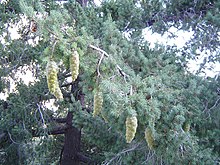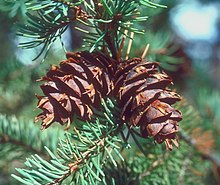Douglas firs
| Douglas firs | ||||||||||||
|---|---|---|---|---|---|---|---|---|---|---|---|---|

Over 100-year-old specimens of the Douglas fir ( Pseudotsuga menziesii ) |
||||||||||||
| Systematics | ||||||||||||
|
||||||||||||
| Scientific name | ||||||||||||
| Pseudotsuga | ||||||||||||
| Carrière |
The Douglas firs ( Pseudotsuga ) are a genus of plants in the pine family (Pinaceae). The common name Douglas fir honors the Scottish gardener and plant collector David Douglas (1799–1834), who discovered the common Douglas fir.
description
Vegetative characteristics
Pseudotsuga species are evergreen trees . The wood is heavy, durable with a dark core and resin channels. The bark is smooth in young trees and later turns reddish-brown and thick. The branches often hang. The needles are alternate and arranged individually on the branch. The needles have two resin ducts in cross section. They last six to eight years. The seedlings have (two to twelve cotyledons cotyledons ).
Generative characteristics
Pseudotsuga species are single sexed ( monoecious ). The female and male cones sit on annual branches. The axillary male cones are cylindrical. The end of the short shoots on a 2 to 10 mm long stalk bent back to hanging female cones ripen in the same year after fertilization . The egg-shaped or cylindrical cones have many spirally arranged seed scales. The seed scales are at least slightly wider than they are long. The cover scales are long, thin and smooth. Like spruce cones, they fall whole from the tree. The whitish seeds are 7 to 12 mm in size with 4 to 14 mm large, light to medium brown wings.
Distribution and paleobotany
The genus Pseudotsuga comprises four species in western North America , China, and Japan .
The genus of the Pseudotsuga was also native to Europe until the last Ice Age . During the ice ages, however, the European representatives of the genus became extinct.
By far the best-known species of the genus in Europe is the Douglas fir ( Pseudotsuga menziesii ).


Systematics
The botanical genus name Pseudotsuga is derived from the Greek word pseudos for false and Tsuga .
There are four species and some varieties in the genus of Douglas fir ( Pseudotsuga ):
- Japanese Douglas fir ( Pseudotsuga japonica (Shiras.) Beiss. ), Homeland: Japan
- Large-coned Douglas fir ( Pseudotsuga macrocarpa (Vasey) Mayr ), native to southwestern California
-
Common Douglas fir ( Pseudotsuga menziesii (Mirb.) Franco ), native to western North America . There are two varieties :
- Coast Douglas Fir, also called Common Douglas Fir or Green Douglas Fir, ( Pseudotsuga menziesii var. Menziesii ), native to Canada, USA
- Mountain Douglas Fir , also called Blue Douglas Fir ( Pseudotsuga menziesii var. Glauca (Beissn.) Franco ), native to: Canada, USA, Mexico
-
Chinese Douglas Fir ( Pseudotsuga sinensis Dode ). There are three varieties:
- Pseudotsuga sinensis var. Sinensis (Syn .: Pseudotsuga sinensis var. Wilsoniana (Hayata) LK Fu & Nan Li , Pseudotsuga wilsoniana Hayata ), native to: China and Taiwan .
- Pseudotsuga sinensis var. Brevifolia (WC Cheng & LK Fu) Farjon & Silba : is native to the Chinese provinces: Guizhou and southwestern Guangxi , typically grows on southern slopes and mountain peaks, on calcareous, stony soils at altitudes of around 1300 meters.
- Pseudotsuga sinensis var. Gaussenii (Flous) Silba : is native to the Chinese provinces: Jingxi , Sichuan and Zhejiang ; is also counted by some authors as part of the brevifolia variety .
Douglas fir gall mosquitoes
Douglas fir gall mosquitoes attack fresh Douglas fir needles and buds. There are three species of the genus Contarinia:
- Contarinia cuniculator Condrashoff, 1961
- Contarinia constricta Condrashoff, 1961
- Contarinia pseudotsugae Condrashoff, 1961 .
These gall midges come from North America . They were detected for the first time in 2016 in Baden-Württemberg , Rhineland-Palatinate and Saarland , in 2017 also in Brandenburg , and in 2018 in Hesse . The larva of the gall midge bores into a freshly budded pine needle. It feeds on the inside of the needle and goes through several larval stages. The damaged needle with the larva falls off in autumn. The larvae pupate in spring. After hatching in late May to June, the mosquitoes only live a few days. When the larvae eat, a section of the needle becomes discolored and loses its rigidity. The species can be distinguished from the feeding pattern: Contarinia cuniculator : needle base, Contarinia constricta : needle tip and Contarinia pseudotsugae : needle center. An infestation with Douglas fir gall mosquitoes will not kill the Douglas fir if there is no additional damage.
literature
- Aljos Farjon: A Handbook of the World's Conifers . tape 2 . Brill, Leiden-Boston 2010, ISBN 90-04-17718-3 , pp. 929-936 .
- Christopher J. Earle: Information on the genus Pseudotsuga at The Gymnosperm Database , 2007, online
- Michael P. Frankis: Generic Inter-Relationships in Pinaceae , in Notes Royal Botanical Garden Edinburgh, 1988, 45 (3): 527-548, (systematics and precise description with detailed sketches of the plant parts of the genera), online
- John W. Thieret: Pinaceae , in: Flora of North America , Volume 2, 1993, ( Pseudotsuga section description), online
- Walter Erhardt among others: The big pikeperch. Encyclopedia of Plant Names . Volume 2. Verlag Eugen Ulmer, Stuttgart 2008. ISBN 978-3-8001-5406-7
Web links
- David S. Gernandt: Pseudotsuga Carrière 1867. In: Pinaceae. The Tree of Life Web Project, January 12, 2005, accessed December 9, 2017 .
- DS Gernandt & A. Liston: Internal transcribed spacer region evolution in Larix and Pseudotsuga (Pinaceae). (PDF) In: American Journal of Botany. 1999, pp. 711–723 , accessed on December 9, 2017 (English).
Individual evidence
- ↑ Lotte Burkhardt: Directory of eponymous plant names . Extended Edition. Botanic Garden and Botanical Museum Berlin, Free University Berlin Berlin 2018.
- ^ Farjon: A Handbook of the World's Conifers , Volume 2
- ↑ SF Condrashoff: Three New Species of Contarinia Rond. (Diptera: Cecidomyiidae) in Douglas-Fir Needles . In: The Canadian Entomologist . 1961, p. 123-130 ( extract ).
- ^ Gitta Langer: First record of Douglas fir gall mosquitoes in Hesse. In: Forest protection info of the NW-FVA . No. 2 , 2019 ( online [PDF]).
- ↑ G Seitz, H Delb, J Grüner, S Mitze, J Wussler: The Douglas fir gall mosquitoes in southwest Germany. In: FOREST PROTECTION INFO . No. 1 , 2018, p. 8 ( online [PDF]).
- ^ B Simko: Douglas-fir. Needle Midge Determining a Spray Schedule Through Use of a Midge Trap. In: Ornamentals Northwest Archives . tape 6 , no. 1 , 1982, pp. 8-10 .

